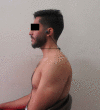Does forward head posture change subacromial space in active or passive arm elevation?
- PMID: 33250012
- PMCID: PMC8366652
- DOI: 10.1080/10669817.2020.1854010
Does forward head posture change subacromial space in active or passive arm elevation?
Abstract
Objectives: Forward head posture (FHP) is one of the most common musculoskeletal disorders that appears to affect the shoulder joint through the shared muscles between the head and neck area and the shoulder girdle. The present study compared the acromiohumeral distance between individuals with normal head and neck alignment and those with moderate and severe FHP in active and passive arm elevation.Methods: Based on the craniovertebral angle, 60 volunteers were selected and equally distributed among three groups, including group one with normal head and neck alignment, group two with moderate FHP and group three with severe FHP. The space between the humeral head and the acromion was measured in 10°, 45° and 60° of active and passive arm elevation as the acromiohumeral distance.Results: The acromiohumeral distance was only different between the three groups at 45° arm elevation angle, and this difference was significant between groups one and three. In active and passive arm elevation, increased arm elevation angle reduced the subacromial space significantly. Also, in each arm elevation angle, the subacromial space differed significantly between the active and passive arm elevations.Conclusions: The acromiohumeral distance was significantly lower in the severe FHP group than the group with normal head and neck alignment in the 45° active arm elevation angle, which could be due to the changed tension in tissues between active and passive arm elevation and also the maximum muscle activity in the 45° active arm elevation angle.
Keywords: Posture; cervical vertebrae; shoulder joint; ultrasonography.
Conflict of interest statement
The author(s) declared no potential conflicts of interest with respect to the research, authorship, and/or publication of this article.
Figures




References
-
- Hertling D, Kessler RM. Management of common musculoskeletal disorders: physical therapy principles and methods. Philadelphia: Lippincott Williams & Wilkins; 2006.
-
- Weon J-H, Oh J-S, Cynn H-S, et al. Influence of forward head posture on scapular upward rotators during isometric shoulder flexion. J Bodyw Mov Ther. 2010;14(4):367–374. - PubMed
-
- Peterson-Kendall F, Kendall-McCreary E, Geise-Provance P, et al. Muscles testing and function with posture and pain. Philadelphia: Lippincott Williams & Wilkins; 2005.
Publication types
MeSH terms
LinkOut - more resources
Full Text Sources
Medical
